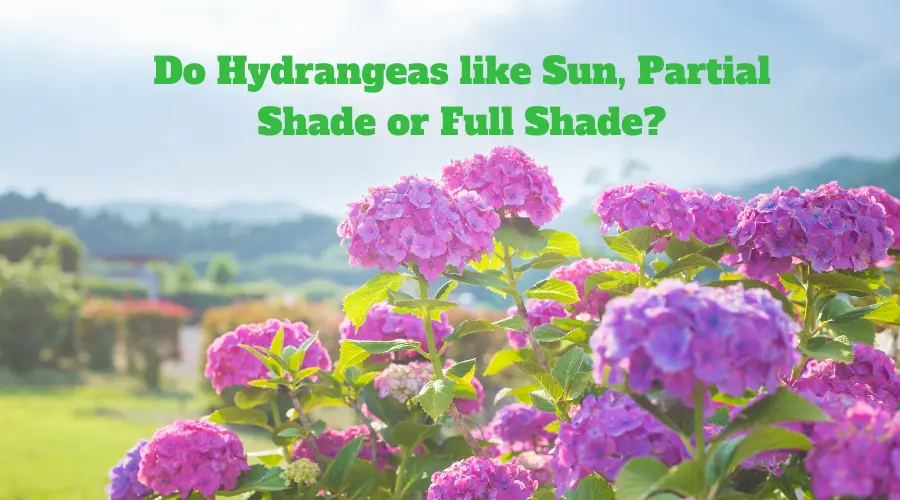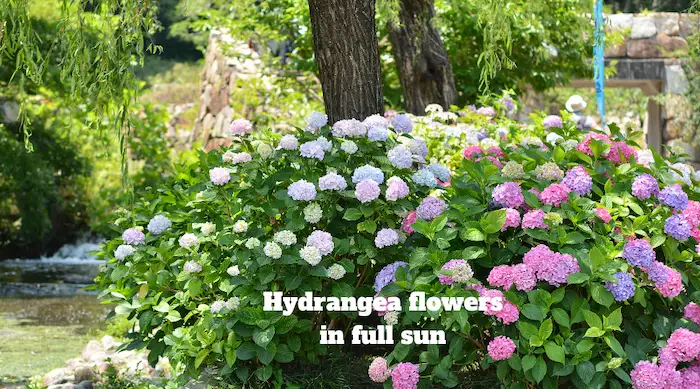Are you trying to decide where to plant your beautiful hydrangeas? You may be wondering if these popular flowers prefer sun, partial shade, or full shade.
The answer isn’t always straightforward, as different types of hydrangeas have different light requirements. In this post, we’ll explore the different light preferences of hydrangeas and give you some tips for choosing the perfect spot for your plants.
So whether you’re a seasoned gardener or just starting out, this post has something for you. Keep reading to learn more about how to give your hydrangeas the best possible sun exposure for thriving.

Let’s get started!
Do Hydrangeas like Sun or Shade?
Hydrangeas are versatile plants that can tolerate both sun and shade. They typically grow best in partial shade, which means you should protect them from direct sunlight during the hottest part of the day.
However, the specific requirements for hydrangea will depend on the variety and the climate it is grown in.
Some of them can tolerate full sun, while others may need more shade. Hence, observe and find out the specific Hydrangea care requirements for the variety of hydrangeas you have and provide the appropriate amount of light.
Additionally, be sure to provide it with adequate moisture, as dry conditions can stress it and cause it to wilt.
Where is the best place to plant a Hydrangea?
As mentioned already, the best place to plant a hydrangea will depend on its variety and the climate where it is grown.
In general, hydrangeas prefer well-draining, moist soil, and partial shade. However, some varieties are more adaptable and can tolerate a range of conditions.
It’s a good idea to check the specific care requirements for the variety of hydrangeas you have and choose a planting location that meets those requirements.
Additionally, be sure to choose a spot that provides enough room for the hydrangea to grow and spread. Planting in an area that is too small can cause the plant to become overcrowded and stressed.
How many hours of the sun do Hydrangeas need?
The amount of sunlight that hydrangeas need will vary depending on the type of plant you own and also the climate of your place. Most hydrangeas prefer partial shade, which means they should be protected from direct sunlight during the hottest part of the day. This is typically around 4-6 hours of sunlight per day.
However, some varieties are more tolerant of the full sun and can handle more sunlight.
Additionally, be sure to monitor your hydrangea and adjust its light exposure as needed to ensure it is receiving the right amount of sunlight. For instance, you can extend the hours of the sun in winter.
Can Hydrangeas take the afternoon sun?
Hydrangeas can tolerate some afternoon sun, but they may be damaged by intense, direct sunlight during the hottest days.
Most hydrangeas prefer partial shade, which means they should be protected from direct sunlight during the afternoon.

Hence, it’s recommended to plant the hydrangea near a structure that provides some shading, such as a fence or wall. You can also use a shading device such as an umbrella or sunshade.
Additionally, be sure to monitor how your hydrangea behaves in different light exposures. You can adjust it as needed to ensure it is receiving the right amount of sunlight.
Can Hydrangeas grow in full shade?
While all hydrangeas can tolerate some shade, they may not thrive in full shade. Most hydrangeas prefer partial shade, which means they should be protected from direct sunlight during the hottest part of the day.
This allows them to receive some sunlight for Photosynthesis but also protects them from intense heat and sunburn. In full shade, hydrangeas may not receive enough sunlight to support healthy growth, and they may become leggy or produce fewer flowers.
Additionally, shade can prevent the flowers of some hydrangea varieties from developing their full color. If you put the plant in full shade during blooming seasons, the blooming can be delayed for a few weeks.
If you want to grow hydrangeas in a shady area, it’s a good idea to choose a variety that is known to tolerate shade and provide some supplemental lighting if possible. The best way to grow a hydrangeas plant is to give them light exposure in the morning and then put it in partial shade in the afternoon.
During the summers, you should place the plant in a shady region in the afternoon to avoid drying out. If mistakenly, you leave the hydrangeas species out in sun, bring them to a shady spot, and sprinkle water.
Hydrangeas Varieties that can Grow in Shade
There are several varieties of hydrangea that can tolerate shade and still produce healthy growth and beautiful flowers.
Some examples include:
1. Snow Queen Hydrangea (Hydrangea arborescens ‘Annabelle’)
This variety has large, white flowers that bloom in early summer. It can tolerate full shade but may produce fewer flowers in low-light conditions.
2. Mophead Hydrangea (Hydrangea macrophylla)
This variety has large, rounded flowers that can be pink, blue, or white, depending on the soil pH. It can tolerate partial shade but may produce fewer flowers in deep shade.
3. Oakleaf Hydrangea (Hydrangea quercifolia)
This variety has elongated flowers that bloom in shades of white, pink, or purple. It can tolerate full shade but may produce fewer flowers in low-light conditions.
4. Limelight Hydrangea (Hydrangea paniculata ‘Limelight’)
This variety has large, cone-shaped flowers that bloom in shades of white, green, and pink. It can tolerate partial shade but may produce fewer flowers in deep shade.
Hydrangeas Varieties that like Sun
Some varieties of hydrangea are more tolerant of sunlight and can handle more exposure to the sun. These varieties may produce more flowers and have healthier growth when grown in sunny locations.
Some examples of hydrangea varieties that like the sun include:
1. Invincibelle Spirit Hydrangea (Hydrangea arborescens ‘NCHA3’)
This variety has large, pink, or purple flowers that bloom in early summer. It can tolerate full sun but may benefit from some afternoon shade in hot climates.
2. Endless Summer Hydrangea (Hydrangea macrophylla ‘Bailmer’)
This variety has large, rounded flowers that can be pink, blue, or white, depending on the soil pH. It can tolerate full sun but may benefit from some afternoon shade in hot climates.
3. Cityline Paris Hydrangea (Hydrangea paniculata ‘Renhy’)
This variety has large, cone-shaped flowers that bloom in shades of pink and purple. It can tolerate full sun but may benefit from some afternoon shade in hot climates.
4. Incrediball Hydrangea (Hydrangea arborescens ‘Abetwo’)
This variety has large, white flowers that bloom in early summer. It can tolerate full sun but may benefit from some afternoon shade in hot climates.
Conclusion
Let’s conclude the post!
Understanding the light preferences of hydrangeas is crucial for ensuring that these beautiful flowers thrive in your garden. Different types of hydrangeas have different light requirements, with some preferring full sun, some preferring partial shade, and others prefer full shade.
To determine the best light conditions for your hydrangeas, it’s important to consider the specific variety you are planting and the specific conditions in your garden. By giving your hydrangeas the right amount of light, you can help them grow and bloom to their full potential.
We hope this post has provided you with helpful information on the light preferences of hydrangeas and that you now feel confident in choosing the best spot for your plants. Happy gardening!

